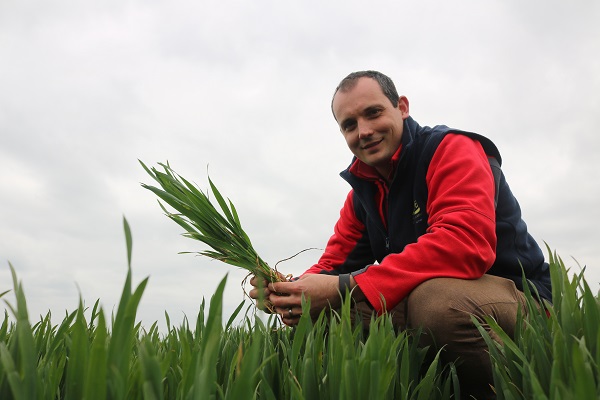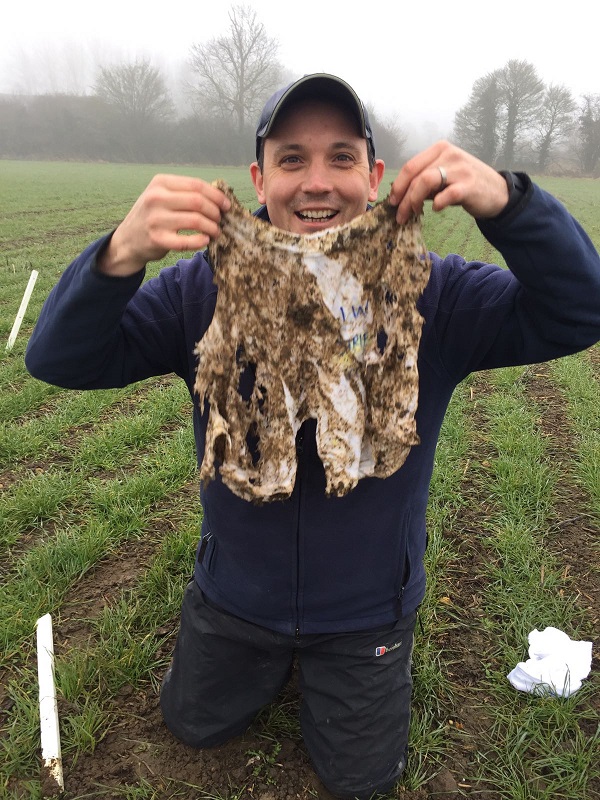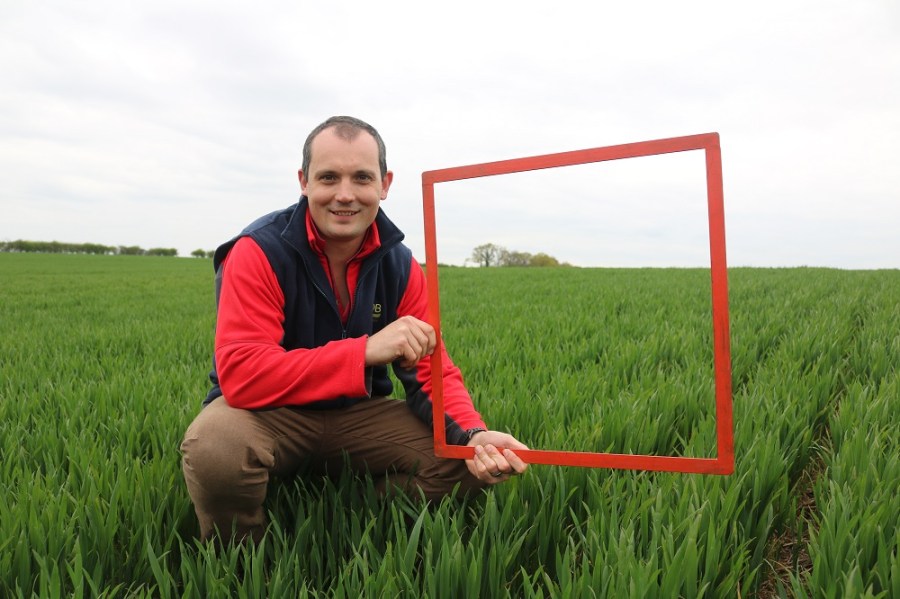A firm focus on plant counts and novel tests for soil biota inform how the Barker boys optimise crop profitability on their stunning Suffolk farm. CPM visits to find out what on-farm trials add.
I don’t want to be known as a land and tree hugger.
By Tom Allen-Stevens
You know you’re in a rather special part of Suffolk when you’re being driven round an arable field and a barn owl suddenly swoops out of a nearby tree. Then a pair of grey partridge break from their cover, scurry along the grass margin and launch into stuttered flight.
For Lodge Farm, near Stowmarket, these are no accidental sightings. Cousins Brian and Patrick Barker have a host of Countryside and Wildlife awards that bear testament to a farming system they’ve honed across their 513ha that ensures the farm’s environmental assets thrive. But Brian Barker isn’t looking at the barn owl nor the partridge.
“That field over there should yield 9.6t/ha, on current estimation, while that one won’t do much more than 8.7t/ha,” he comments. “Over there we’re expecting 10.1t/ha, while the Real Results field, in Leeds winter wheat, is on target for 11.2t/ha.”

For Brian Barker, the above and below-ground monitoring provide the level of detail he needs to make informed changes, and to take to discussion groups.
His real enthusiasm lies in how he can manipulate an arable crop – monitor its progress throughout the season and make subtle changes that’ll ensure it yields its best. This is what’s led him to join BASF’s Real Results Circle – a group of 50 growers coming together and sharing results from on-farm trials to find out what really works in the field. And while the Barkers farm with wildlife in mind, it’s high-yielding crops that drive the business.
“We’re LEAF Demonstration farmers, and we’re blessed with a farm that has 43km of hedgerows and 30 farmland ponds among its environmental features. A recent bird count shows we’ve over 100 species, 28% of which are on the RSPB Red List,” he notes.
“But I don’t want to be known as a land and tree hugger. The conservation bits mean we can farm in straight lines and take less economic land out of production. If conservation should start impacting on the crops, we’d change our management.”

Several pairs of 100% cotton underpants have been buried in different fields to measure soil biological activity.
It was a passing comment he made a couple of years ago that focused his mind on crop performance. “I told someone I hoped our wheat would yield 10t/ha, and realised I ought to have a clearer idea. Our best wheat crop was actually yielding 4.2t/ha better than our worst, so we were clearly spending too much trying to get our worst crops to perform and probably not enough on the best.”
He started meticulously taking plant counts and recording these throughout the season, using the AHDB Growth Guide to assess potential. Differences became apparent in varieties and establishment techniques – Leeds, Zulu, KWS Santiago and Grafton make up the 240ha winter wheat crop across the Beccles series silty/clay loam, established with a strip-till 5m Sumo DTS drill or a 4m Sumo Direct Drill.
“I took 241 plant counts soon after emergence and then another 122 counts in early spring. It helps you assess which crops should get the prime fungicide spend and which would do better if they received a biostimulant,” he notes.
“Leeds raced out of the blocks, establishing 108% of its target population. It has 3.4 shoots/plant against a farm average of 3.15, so now it all depends on how many grain sites each shoot can deliver. Zulu has fallen to bottom in terms of potential, but I’d never have known that in previous years. We’re now farming to crop potential, not hope.”
And it’s not just above the soil surface where Brian Barker’s interest lies. “Through Twitter, I came across a Canadian Nuffield scholar, Blake Vince, who buries cotton underpants in his soil as a measure of biological activity. We’re an AHDB Monitor Farm and I suggested to the rest of the group we should have a ‘pant off’.”
He duly purchased six pairs of 100% cotton underpants in Sept last year and buried them in various fields, keeping Twitter informed of progress via the hashtag #soilmyundies. The craze to consign hapless underwear to the mercy of soil microflora took off, and farmers across the UK have littered Twitter with the tattered remains of soiled undies ever since. “They’re buried to spade depth for about eight weeks, and I’ve repeated the monitoring with the fourth set still underground,” reports Brian Barker.
He set up an exhibition of the ragged pants at an AHDB Monitor Farm meeting, and this threw up some fascinating insights into just what his soils were up to. “The most completely destroyed, so most biologically active soil, was a strip-tilled second wheat. But we must have done something to the soil where we’d min-tilled because here the pants were intact. Likewise, an overwintered plough going into spring crops had very little decomposition – I could practically wash and wear those undies.”
The more cultivation the soil has, the less active the microflora, he concludes. “One interesting situation was over-wintered cover crops – here I was left with little more than a threadbare thong when they were retrieved at the end of Jan. But then the crop was sprayed off and soil activity clearly reduced – there was very little decomposition when I dug up the next pair in March.”
For Brian Barker, the underwear monitoring, the plant counts and the on-farm trials he carries out build into a whole, integrated approach to farming that keeps its focus on profitability, but neatly complements the rich and diverse wildlife of the farm. But they also provide the level of detail he needs to make informed changes, and to take to discussion groups.
“The idea is to have flexibility,” he states. “When my grandfather took this farm on in 1958, he would have adapted his equipment and resources to suit any situation. As farming has consolidated, we’ve lost a lot of that. But now we’re going back to that more flexible approach, informed by a detailed knowledge of what we have in the field and a thorough understanding of the technology available.”
Trials provide Real Results for on-farm discussion
Lodge Farm is among 50 farms that have joined the Real Results Circle – an initiative that will allow farmers to conduct their own on-farm trials, backed by BASF.
Four tramlines have been set out in a 10.4ha field of Leeds winter wheat, and these will be monitored and assessed throughout the season by ADAS and AgSpace, who are providing technical support and helping the Barkers apply a reasonable degree of scientific rigour to the trials.
Drilled on 23 Sept at 361 seeds/m², the target was 300 plants/m² but 309 plants/m² actually established after 15 days. “This dropped to 277 plants/m² by 20 Feb, but shoot counts on 4 April revealed we have an average of 1085 shoots/m², or 3.91 shoots per plant – that’s well in line for a target yield above 11t/ha so it’s a crop worth spending on,” notes Brian Barker.
The trial itself pitches the farm’s own disease-control programme against one based on Adexar and Librax, with free samples of the Xemium fungicides supplied by BASF (see table below).
“I haven’t decided what T2 spray to apply – it’ll depend a tiller count and weather, although it’ll probably include an SDHI in the higher potential fields. But I don’t think we’ll spend as much as the BASF programme – I’m not so sure that will pay dividends over my tailored approach,” says Brian Barker.
Within the 50 farms are five CPM readers whose progress is being closely monitored, with updates provided throughout the season in subsequent issues of CPM and through www.cpm-magazine.co.uk The CPM website’s the place to go for full profiles on the CPM featured farmers, progress reports, Real Results Pioneers features and links to more at www.basfrealresults.co.uk
What’s more, five farms are due to host agronomy and trials demonstrations, taking place over the summer, which will be free for any farmer or agronomist to attend. The five farmers are:
- James Forrest, Mowness Hally, Little Stonham, Stowmarket, Suffolk;
- Richard Hinchliffe, Dikes Marsh Farm, Rawcliffe Bridge near Goole;
- Russell McKenzie, Howson’s Lodge, Old Weston, Huntingdon;
- Russell Price, Town Farm, Castle Frome, Ledbury, Herefordshire;
- James Hopkinson of Arable Ventures, West Inliston Farm, Forfar, Angus
The demonstrations at these Real Results Farms will include wheat variety, fungicide, PGR and oilseed rape trials, and will give attendees a chance to see BASF’s pipeline chemistry in trials.
Richard Hinchliffe and his family have partnered BASF for over 20 years, running wheat trials and implementing extensive biodiversity work. The farm is regularly host to politicians, NGOs, food supply chain and local residents for advocacy work demonstrating the partnership between production agriculture and farm wildlife. He carries out all of the farm’s agronomy work and is a current Nuffield Scholar researching herbicide resistance.
“The Real Results crop of Grafton winter wheat looks well with little disease apart from a small amount of old Septoria tritici on the bottom of the plant,” he comments. “We’ve only had 15mm of rain since the start of April and if this continues it’ll be a worry. But I’m a big believer in our no-till crops – they have better rooting and therefore resilience to moisture stress.”
He applied Vertisan (penthiopyrad) plus epoxiconazole at the T1 spray timing, pitched against Adexar, and the plan is to put the Real Results programme against Ascra (bixafen+ fluopyram+ prothioconazole) at T2.
Russ McKenzie’s choice for the T1 spray on his KWS Siskin was Elatus Era (benzovindiflupyr+ prothioconazole). The plan at T2 is to use Ascra (bixafen+ fluopyram+ prothioconazole) or Aviator (bixafen+ prothioconazole).
“The crop looks OK, all things considered,” he comments. “The top end potential may have been lost with the dry conditions and we really need some decent rain between now and flag leaf. But it’s a testament to the crop’s rooting ability that it’s scavenging moisture from somewhere.”
The open days at all five Real Results Farms will run throughout the summer and include guided plot tours from breeders and independent experts, first hand explanations from the host farmers and some “fabulous local food and drink.”
The progress and details of the five demonstration farms and the 50-farmer trial can be followed at www.basfrealresults.co.uk where those interested can also register for the open days.
Lodge Farm’s Real Results trial

The Real Results Circle
Farming in the UK has never before been confronted with such a perfect storm of uncertainty.
Uncertainty over where the industry is headed post Brexit; uncertainty of returns, because of fluctuating prices and stagnating yields; uncertainty over the removal of chemical active ingredients from the arable toolkit, and uncertainty over which of the mind-boggling array of new products, technologies and tools would be best to try to get to grips with.
To combat growing uncertainty, BASF and CPM are encouraging everyone with a passion for UK farming to unite. We want to help form an agricultural knowledge network of experts, industry specialists, agronomists and farmers.
We want farmers to share their knowledge and conduct on-farm trials. By coming together to face challenges as one, we can find out what really works and shape the future of UK agriculture.
This year, BASF’s Real Results Circle is exploring wheat fungicides and oilseed rape profitability. This series of articles in CPM profiles some of the growers who’ve joined the Real Results Circle, giving an insight into how they optimise returns from their crops. We’ll also have topical advice and expert guidance from ADAS on how to get the best from on-farm trials.
To keep in touch with the progress of these growers and the trials, go to www.basfrealresults.co.uk




